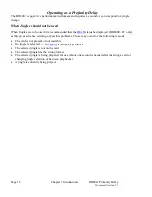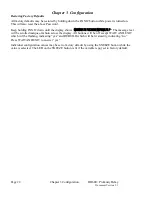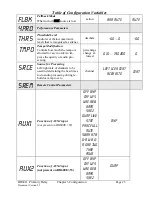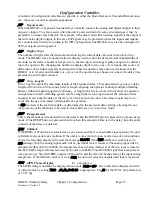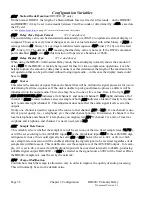
Operating as a Profanity Delay
BD600+Profanity Delay
Chapter 2 Operation
Page 17
Document Version 2.1
The display is configurable to be blank, or to show 1, 2, 3 or 4 digits of resolution of delay length. In
bypass the display will show ‘----‘.
If the unit is
in-line
, and configured to use AES or Wordclock as a sync source and it loses lock, the
display will scroll “
NO LOCK
.”
See
Notes and Warnings for AES/EBU Operation
on page 10
More Information on the PANIC feature
The PANIC feature is designed to offer some protection against undesirable input audio when the de-
lay value is
unsafe
. It is also useful as a convenient way to get into delay at the start of a show.
Hitting the PANIC button causes the delay to be instantly set to zero and then filled with input audio in
real time. During this time, a jingle may be played from the Compact Flash card, or the output muted.
If the input is being monitored, DUMP or SNEEZE may be used in the normal way.
If a suitable jingle file is selected on the card it will be played, and the
panic
mode will terminate at the
end of playback. If the length of the jingle is greater than the configured maximum delay value it will
play to the end, but the delay will only be filled to the configured maximum value.
See
Chapter 3
to select the jingle file.
If no suitable jingle is selected on the card (or the card is not present) and the PANIC (
PANC
) time is not
configured to
OFF
, the output will be muted for the PANIC time, allowing an external cart to be played
if desired. After this time, the
panic
mode will terminate, with the delay filled to the configured
PANIC time.
See
Chapter 3
to configure this.
Once the
panic
mode has terminated, the unit will go to
rebuild
and the delay will play out, starting
with the audio immediately after the PANIC button was hit. A
panic
operation may be ended early by
hitting the PANIC button again. (Prior to V1.4, this would mute the audio until the operation com-
pleted).
If the PANIC time is configured to
OFF
and no suitable jingle is selected on the card, the PANIC fea-
ture will be disabled and the button will be unlit.
Jingle files on the card
Jingle files can be recorded on a PC (IBM-compatible Personal Computer) using any suitable software.
These can be saved to a suitable Compact Flash (CF) card using a commercial CF card reader/writer.
These are usually connected to the PC via USB (Universal Serial Bus) and are widely available.
The files must be 16-bit stereo .WAV files longer than 1.0 seconds, created with the sample rate to
which the BD600+ is to be operated. If these requirements are not met, either the BD600+ will not rec-
ognize them, or they will be played at the wrong speed.
The BD600+ can support up to four different jingles per card – they must be named ONE.WAV,
TWO.WAV, THREE.WAV and FOUR.WAV respectively. These names may be in upper or lower
case. The active jingle can be selected either by changing the configuration variable
JING
, or by remote
control. If the selected jingle is either not valid or not present, or there is no card in the slot, a
BAD
JINGLE
message will appear briefly. The
JBAD
status will be displayed if configured.
See
Chapter 3
to configure jingle selection.
See
Appendix A
for information on remote control.
Cards should not be removed or inserted when the unit is not
bypassed
.
Summary of Contents for BD600+
Page 2: ......
















